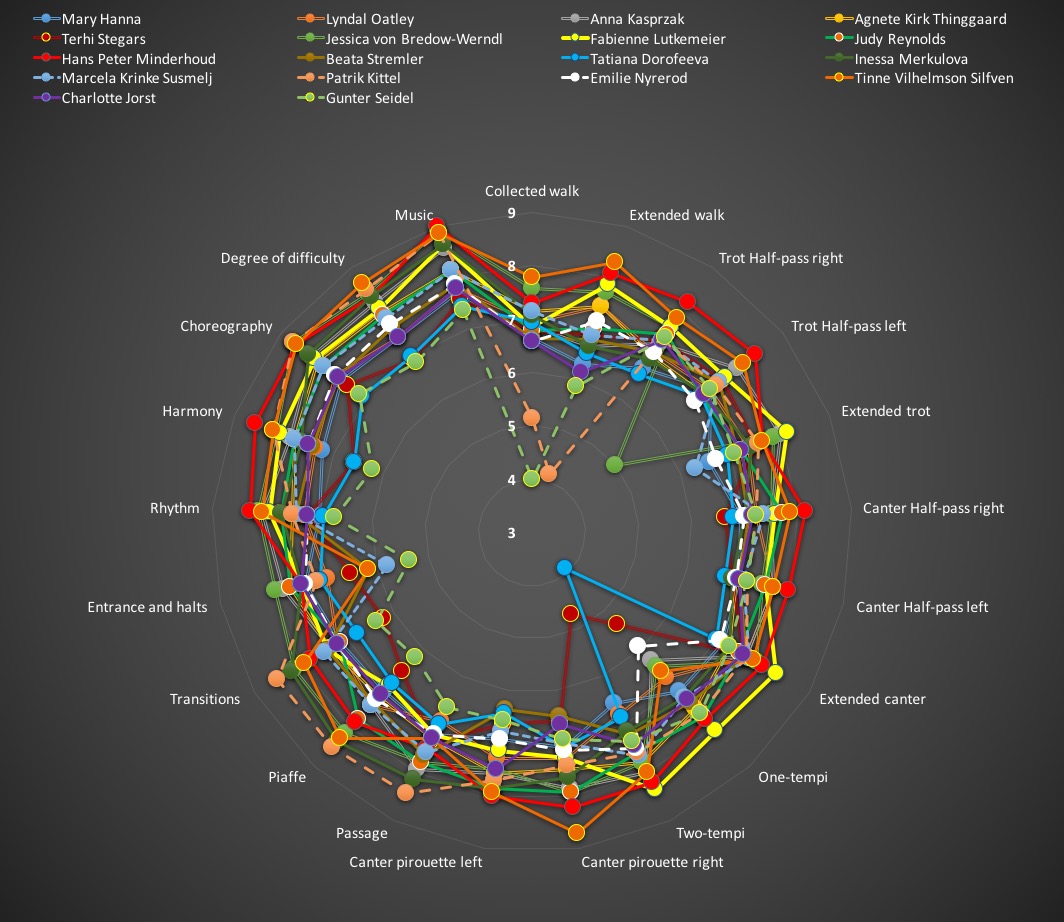Интересная диаграмма.
Доктор Дэвид Стикленд из компании «Global Dressage Analytics» опубликовал диаграмму «Анатомия выездки», которая построена на результатах КЮРа Большого приза финала Кубка мира ФЕИ по выездке в Гётеборге этого года. Каждому из всадников «присвоен» свой цвет: у Инессы Меркуловой – тёмно-зелёный, у Татьяны Дорофеевой – синий, у Ханса Петера Миндерхуда – красный. Все показатели и элементы высшей школы расположены кругом, каждый из них оценивается по 10-балльной шкале.
Из новостей Зол. Мустанга
И вот с
сайта интересная статья про форум, вначале про ковку.
Six-time international farrier champion Grant Moon is an absolute genius when it comes to shoeing horses. Not only is he good at doing what he does but he is able to articulate it in a fun and witty manner. His visual aids were effective in showing us how to identify what needs to happen for safe and healthy feet. I recorded a Sound cloud of his talk you can check it out here:
Since moving to Florida I have had some difficulties in getting a good farrier, my biggest question has been. “How do I find a good farrier?” I think he did a good job of answering most of those questions.
His key points:
Your farrier should be educating themselves continuously, they should be attending seminars etc, because if you are not moving forward you are moving backwards.
Indefinite soundness is rare, so it takes a team of people to ensure a horses well being in sport, including a vet, farrier, coach, saddle fitter etc. He also jokes that you probably aren’t working hard enough if your horse is never sore.
Foot distortion happens but changes in hoof will tell you that the hoof is under stress.
How to identify a flare; hoof is longer on one side causing the hoof wall to bend
Long toes, high heels, over lowered heels they are all bad
Too much heel affects posture in much the same was as a woman wearing stilettos. Now this may not have been the greatest analogy for the DQ in me cus in my head I think I look amazing in heels and so might my horse!
He identified a shoeing profile in which these are all of things you need to take into account when shoeing a horse.
Type of sport
Experience of rider
Conformation
Age of horse
Surface conditions
Trim
Shoe selection
Nail selection
Hoof balance
Hoof type
Recognize and control hoof distortion
Maintain hoof integrity
He suggests that in addition to taking into account these factors it’s a good idea to have the farrier watch you ride the horse.
I am meeting up with him privately today for a part two so stay tuned for that!
Steffen Peters was brilliant as always. This session was mostly a repeat of what was said at the FEI trainers conference last week and you an check out my notes on that here.
In a Maury Pauvich question and answer style period with Andreas, Steffen was asked about his training routine, he spoke about his personal trainer and how they work to activate the core in each exercise that they do. I bring this point up because my Canadian friends are visiting and they also mentioned how fit everyone is here in Wellington. To further his point Steffen also noted that his weight will only change 2 to 5 lbs and while some people feel that may be a bit obsessive, he feels that it is the weight at which he feels the best while riding.
Arthur Kottas taught us the basics of long lining a horse. Unfortunately this session was not well planned. We sat for almost an hour watching his Dressage Clinic.com video, by then he had lost the attention of the crowd and run over time already.
Then he brought out two horses for a live demo and still had to address the panel. He is brilliant at the in hand work and it was well worth watching, but it is slow and patient work and the audience attention really started to dwindle as we were getting into the late hours of the night.
Finally, Rudolph Zellinger took the stage. The forum was scheduled to go from 1pm to 1030, he took the stage an hour late and while Andreas conducted his Maury Pauvich style questions the crowd actually got angry and started calling out that they wanted the horses in order to rush the question and answer piece. To further anger the crowd Andreas kept on asking his questions. Just before 1030 at night the live riding section started.
As I struggled to keep my eyes open (perhaps a side effect of a Sunday night at the Players club here in Wellington), Rudolph spoke about how important it is to individualize programs to each horse. He likes to warm up horses in the sitting trot because he finds it easier for them to obtain self carriage and contact. It also aids the temp and mental preparation.
When he first comes out, he expects a smaller trot from his horses until they are thoroughly warmed up. Such a small thing but a big lesson learned for me while watching horses here in Wellington, most of the big movers have pretty ordinary trots in the warm and then they become OMG trots.
A horse ridden correctly should still be able to stretch in his neck in piaffe or a canter pirouette.
Success in the young horse tests lies in the responsibility of a good trainer, a good trainer knows that some horses take more time and can evaluate what is best for their horse, sometimes that means not doing the young horse test and allowing the horse a longer path to the development for the Grand Prix. He mentioned he starts the piaffe and passage work early so that he has 3 years to develop it, that way if it takes a step backwards its not a big deal you can just keep working away at it patiently.
